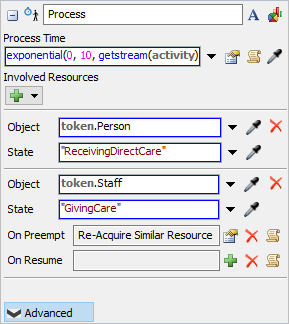Process
Overview and Key Concepts
The Process activity, like the Delay activity, will hold the token for a certain length of time. You can use a fixed time or you can create the delay time dynamically using a label value on a token, a statistical distribution, etc.
Additionally, the Process activity manages the resources involved in the process. These resources will have their state set to the user-defined state. For those resources marked as preemptable, the resources will be made available to be acquired by requests in a higher priority tier. The Process activity also allows you to define what should happen if a resource is preempted away.

Connectors
The Process activity only allows one connector out. See Adding and Connecting Activities for more information.
Properties
The following image shows properties for the Process activity:

Each of these properties will be explained in the following sections.
Name
Used to change the name of the activity. See Name for more information about this property.
Font
The Font button
 opens a window to edit the activity's
background color and font properties. See
Font for more information
about this property.
opens a window to edit the activity's
background color and font properties. See
Font for more information
about this property.
Statistics
The Statistics button
 opens the activity's statistics
window. See Statistics
for more information about this property.
opens the activity's statistics
window. See Statistics
for more information about this property.
Process Time
The Process Time defines the amount of time that the token will be delayed.
Involved Resources
The Involved Resources panel defines who and what is involved in the process. When you add an Involved Resource you have the option to add a Non-Preemptable or Preemptable resource. Both have the following properties:
- Object - The object(s) that make up this class of resource.
- State - The state that the objects defined above will be put into after starting the process.
Preemptable Resources have the following additional properties.
- On Preempt - Here you define what to do if one of the objects defined above is preempted.
- On Resume - Here you define what to do when a preempted resource is reacquired or replaced.